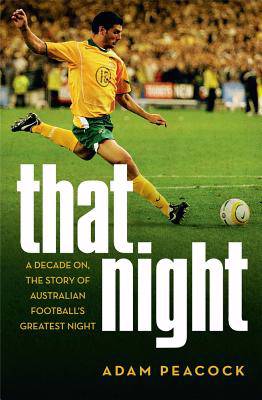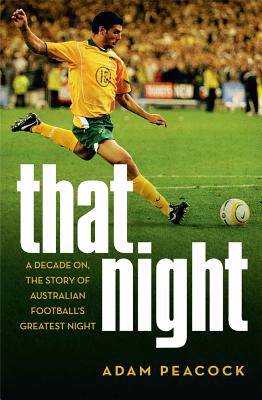
- Afhalen na 1 uur in een winkel met voorraad
- Gratis thuislevering in België vanaf € 30
- Ruim aanbod met 7 miljoen producten
- Afhalen na 1 uur in een winkel met voorraad
- Gratis thuislevering in België vanaf € 30
- Ruim aanbod met 7 miljoen producten
Zoeken
Omschrijving
Wednesday, November 16, 2005: 80,000 people at the Olympic Stadium in Sydney, millions around the country couldn't believe what they had witnessed. The Socceroos, after a 32 year wait had qualified for World Cup. 32 years of heartache, despair, and a sleeping giant of Australian sport continuingly falling into a deeper and deeper sleep thanks to infighting and incompetence, was awake. After 2 hours in Sydney, and 90 minutes in the seething atmosphere of Montevideo 4 days earlier, Mark Schwarzer's giant hands and John Aloisi's magical left foot allowed Australia to sneak past Uruguay in a penalty shootout--the worst and best way to end a contest of this magnitude. That Night isn't just about a game of soccer, though. It delves into the story of why Australians had to wait 32 years, talking to the players who lived through those nightmares. Losing to New Zealand in 1981, Scotland in 1985, a Maradona-inspired Argentina in 1993, and its most haunting nightmare, Iran in 1997. The players that were on the field tell their stories like never before of how they got to that moment, what their role in the success on That Night was. It wasn't simply a case of showing up to play two games against Uruguay. This was the culmination of a career spent mainly away from these shores to get somewhere in the world's biggest sport. Kewell, Aloisi, Viduka, Emerton, Culina, Grella, Bresciano, Popovic, Vidmar, Skoko. Who knows where the sport would be if they didn't get to the World Cup. Certainly nowhere near where it is now. The Socceroos got the attention, Australia got worldwide recognition at the 2006 World Cup, the A League grew, marquee names eventually made their way to play here, professionalism and corporate interest went to new levels, far, far removed from the days of struggle pre-2005, when the A League started. It all changed, That Night.
Specificaties
Betrokkenen
- Auteur(s):
- Uitgeverij:
Inhoud
- Aantal bladzijden:
- 336
- Taal:
- Engels
Eigenschappen
- Productcode (EAN):
- 9780857989321
- Verschijningsdatum:
- 1/02/2016
- Uitvoering:
- Paperback
- Formaat:
- Trade paperback (VS)
- Afmetingen:
- 152 mm x 231 mm
- Gewicht:
- 480 g

Alleen bij Standaard Boekhandel
+ 94 punten op je klantenkaart van Standaard Boekhandel
Beoordelingen
We publiceren alleen reviews die voldoen aan de voorwaarden voor reviews. Bekijk onze voorwaarden voor reviews.








